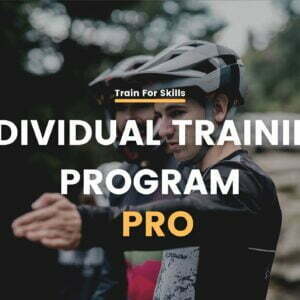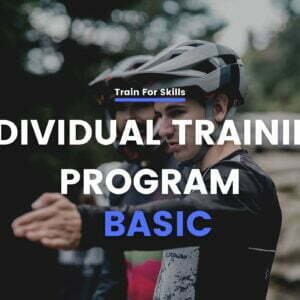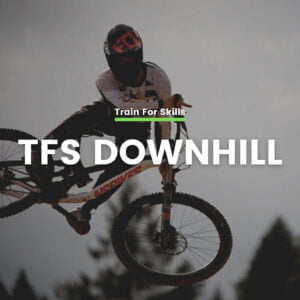Durability – Advanced Features
Around January-February, there is a breakthrough in the training of many cyclists. This is the moment when intervals return after rest and calmly build the training volume. These are the workouts that you would like to skip sometimes 😉 Lactic acid will flood your muscles again. Hated by many, but essential to development. Anaerobic, mystical power and iron calf – what is it all about? About how to train endurance during the special preparation period, in today’s article.
4 stamina factor
Everything we’ve covered so far in previous blogs has happened in the oxygen energy system. The most intense efforts take place in the so-called ‘Anaerobic system’, i.e. the anaerobic system. These include sprints and sudden bursts, among others. In general, we can describe such a level of intensity of exercise as one during which you are unable to pronounce more than a few words in a sequence.
Bompa and Buzzichielli describe the ability to work at high intensity as high intensity endurance (HIEE for short). It is the fourth endurance factor along with Vo2max, lactate threshold and cost effectiveness. This is definitely an important point, especially in Downhill, where the efforts are shorter, stronger than in enduro.

Periodization in a nutshell
During the special preparation (a.k.a. build-up) period, we start working on specific advanced traits. The basic qualities are maintained. The overall volume of our workouts has peaked and is starting to slowly sink down. However, for enduro it will still be at a relatively high level. Why?
It is because of the demands of the race that are served to us. We spend on average 5-8 hours on the bike on days like this. Body and mind must be prepared for it. And high endurance is key. Such long days in the saddle are normal for an enduro rider (in downhill there is much less time ‘in the saddle, pedalling’). Each special preparation period usually ends 4-6 weeks before the first important race of the season. At this point our form should be in ~90-95%.

Typically, we start this period with ‘tempo’ i.e. riding 60-120min at a steady pace in zone 3. Then we move from longer 15-20min aerobic intervals in zone 3-4 at LT threshold to shorter ~10min close to FTP threshold in S4. Examples of such units are in the previous blog. Next up is strength endurance (efforts of 6-12min ~S4 HR) just before VO2max (interval work of 3-5min or reps of 40-60sec).
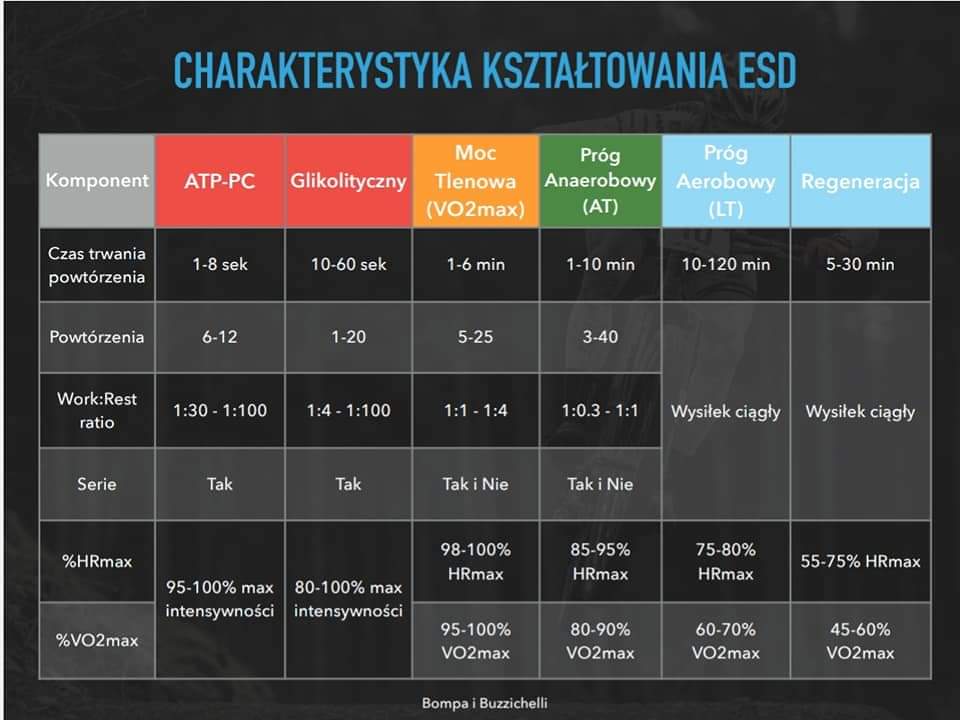
The last 2 abilities fall into the anaerobic capacity range. These are anaerobic endurance and neuromuscular power. Both these abilities we train also outside the bicycle – at the gym or e.g. pumptrack. On our own, we do the starts and sprints shortly before a competition or in the period between a series of races. This is already in the competition phase, not the special preparation phase of our annual training plan. Then we stabilize our race form and fight for the final 3-5% or less for professional athletes performance. Popular then is the use of the so-called tapering (but more about this closer to the start season)
Aerobic Zone
- Tempo – or working at S3-4 heart rate/power. This is the zone in which we usually spend most of our time during Enduro races interspersed with stronger accents (i.e. oesy, steeper uphill sections). Using the continuous method we ride for 40-60min in S3 preceded by a warm-up. To shape the pace we can also use the repetition method. We do 3-4 repetitions lasting from 10 to even 30min. Examples of such units are 4×10′ in S4 HR (2.5′ RI in S2 HR) , 3×15 in S3-4 HR (3’45” RI in S2 HR), 3×20 in S3 HR (5′ RI in S2 HR) or 2x30min in S3 HR (7.5′ RI in S2 HR). The shorter the effort the closer we will want to be to the lower limit of zone 4.
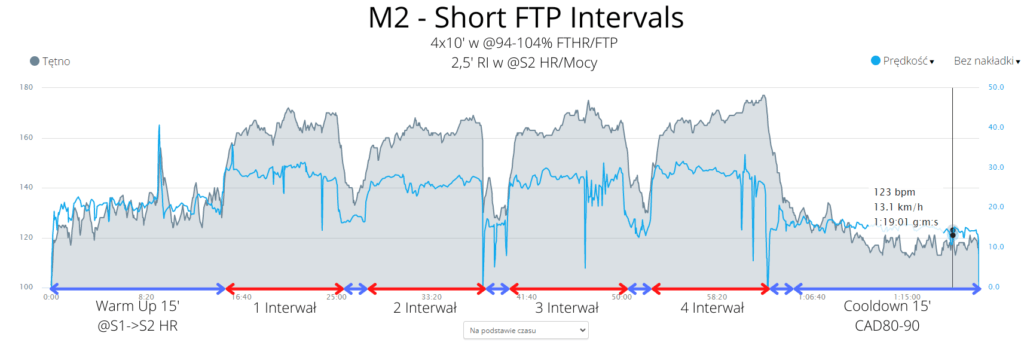
- Strength endurance – these are efforts lasting ~6-12min. For interval training we do 3-6 reps, with a shorter break of 2-4min in between. Generally this is work at S4 of heart rate/power. The benefits we get are increased comfort during the race, higher power at lactate threshold.
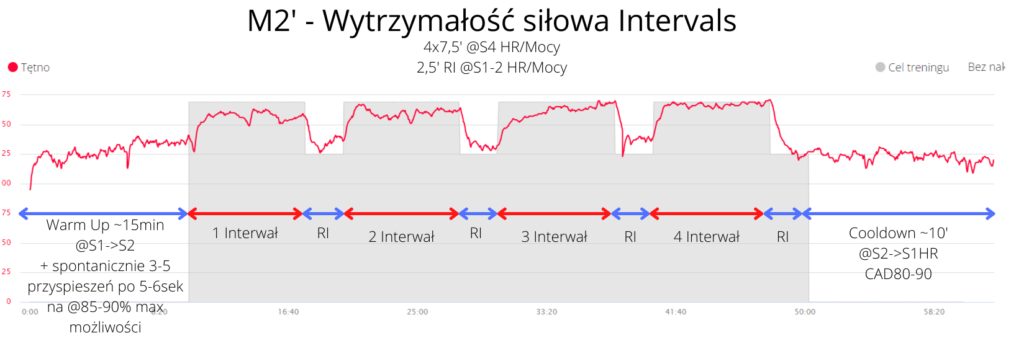
- VO2max – aerobic power can be shaped in two ways. The first one is high-intensity, short repetitions ~40sec. The second one is the range of 3-5min effort at S5 of heart rate. A classic workout often performed by TFS clients is 4-5×5′ at S4-5 heart rate (graphic). We then use the interval method. Work : Rest ratio for longer repetitions should be ~2-1:2 and 2-3:1 for shorter repetitions. By shaping VO2max we also develop anaerobic endurance. By performing 4 series of 4 repetitions of 40 seconds (20sec RI repetitions and 5min between series in S2 HR/power) we will shape VO2max in the first way.
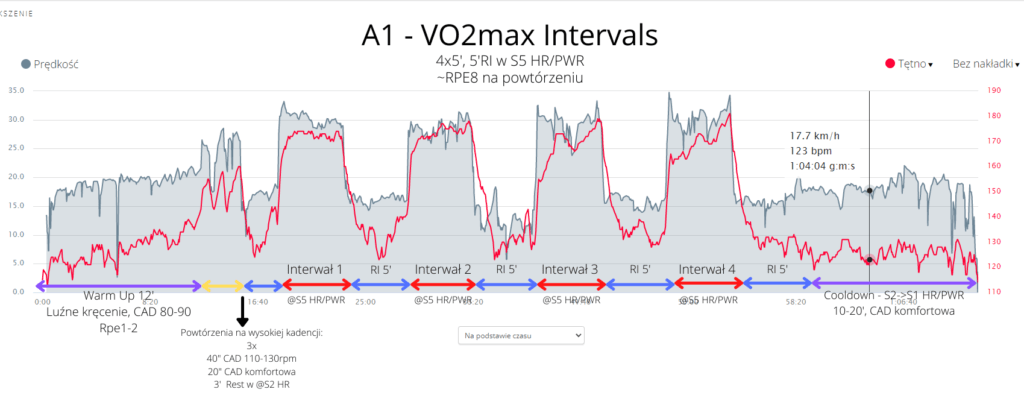
Anaerobic Zone
- AT/’anaerobic’ threshold – strong, closer to maximal efforts lasting from 20sec to 2min. Using series and repetitions we can influence the capacity of anaerobic system. For this we do 2 series of 4 repetitions of 100 seconds >S5 HR / S5-6 Power. Between repetitions we take a break of 3min 20sec in S1-2 HR and 5min W S1-2 HR between series. For strictly power this system we can do 10-15 reps in S6 Power/ >5 HR lasting 45sec with 90-120sec break in S1-2 between.
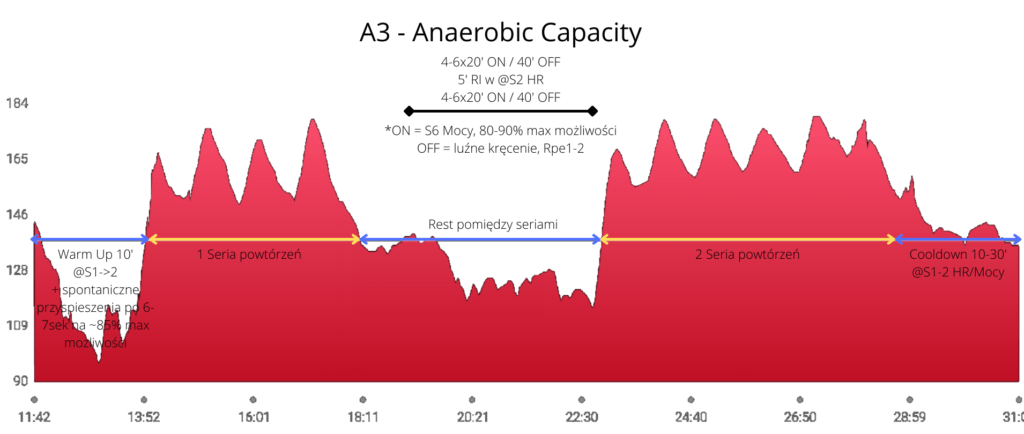
- Neuromuscular power – maximum, very short efforts. In the field we can usually break these down as follows: starts (<6-8sec work), short sprints (~15sec) and long sprints (~25-30sec). Additionally, sprints can be performed from a standstill or with a certain initial speed, e.g. while riding a trail. The most common method used here is series and repetitions. In order to practice starts we can do 4 series of 4 starts. Pause between sets of ~4min at S2 HR/power, and between sets of ~80sec. In case of these workouts strong warm-up is especially important, therefore it is useful to do for example one 5-minute interval at S4 HR/power before sprints/starts.
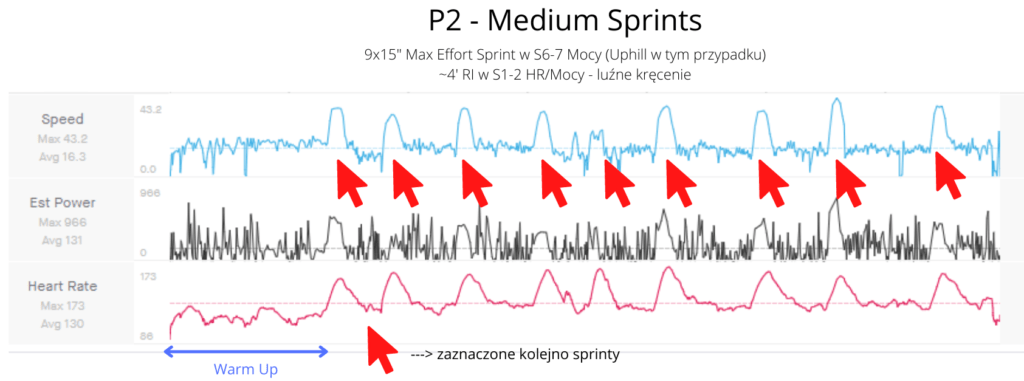
Specific methods
The methods presented above are classic training methods. Classical means as described in the scientific literature. But nowadays there are many other interesting and effective possibilities for such training. Hours on the road is not the only possibility.
What is important to note – during the development period our goal is to specialize in a given discipline. Workouts develop skills focused strictly on it. Usually in this period riders spend more and more time on DH or Enduro bike. Other activities recede into the background or disappear altogether.
That is why in many cases it is more sensible (logistically and time-wise) and purely beneficial to combine fitness training with time spent on the bike in the field.
Pumptrack
One of the best methods of shaping anaerobic capacity, technique and fluidity. Depending on the track a single ride usually lasts 30-90sec. This is the ideal length for anaerobic work at maximum speed. For example, we can perform a session consisting of 15-20 repetitions (runs) at 100% lasting ~30-45sec. In between there is a break of 2-4min at S1-2 HR while riding around the track or simply sitting on the bike at a standstill. Such training is not only great for fitness, but also for technique. Pumping, position in the banks, manual over moguls, smoothness. These are some of the aspects we can improve!
Riding at your local spot
Let’s say you have a hill that takes 8-10 minutes to climb (45-90 seconds to descend). One of the workouts you can do is 8-15 ascents at S4 HR/Power preceded by descents at max capacity. After the climb you rest for 3-5min and after the descent you rest for 45-60sec. This is another way to combine technique and fitness training with time spent on the bike in the forest.
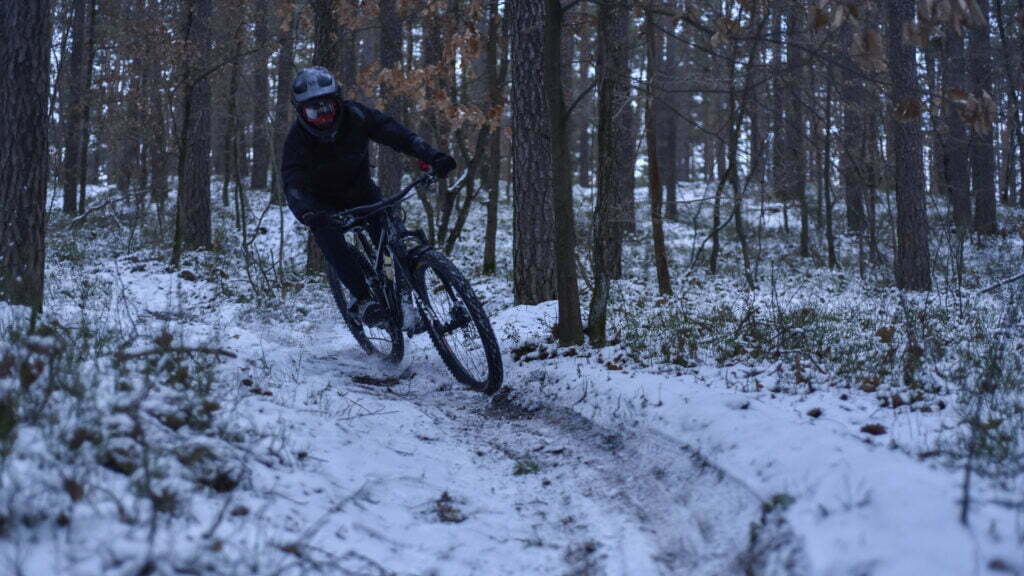
Not having access to big hills makes it difficult to get used to descending 6-15 minutes. This is especially important in enduro, where the average time of an event is so long. Such time we are not able to ride at 100%. Often the last 1-2min at a competition is on ‘soft legs and hands’ and you have to get used to it! On short descents (up to 2-3min) we can do a sprint ~30sec before the descent. This way we start each run at a higher heart rate. Another option is to do descents directly after the climb (0sec rest), when the descent is really short (up to 1min). This way we can do for example 4 series of 6 downhill-runs without a break.
Enduro day
5-8 hours spent on a bike, preferably on bigger hills in the mountains. Such a session is great for the overall volume of work and getting used to long time ‘in the saddle’. 1000-2000m of elevation gain and 20-70km of distance is a range we should aim for during such days. Personally, I would focus more on vertical meters than distance – in case of enduro, not road.
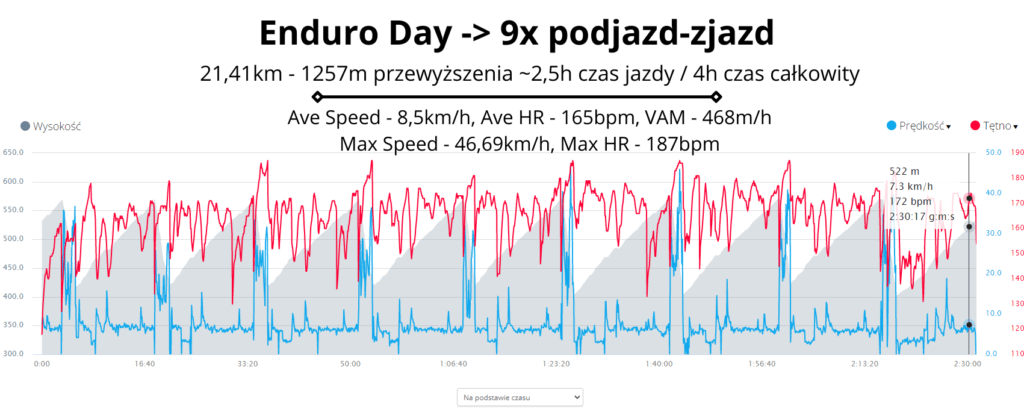
Combined fitness workouts
Such workouts are often used during the competition season, when we optimize the time spent on the bike and strictly training. In advanced athletes it is common practice to use them year-round. Such people have so developed energy systems that such combinations give them more benefits. Third possibility, when we use them is in people with lack of time. The key factor for such people is the efficiency of each training unit. An example of such a session is doing sprint repetitions before a 2-3h enduro ride. Another possibility is to combine spot starts with endurance riding at S2 heart rate.
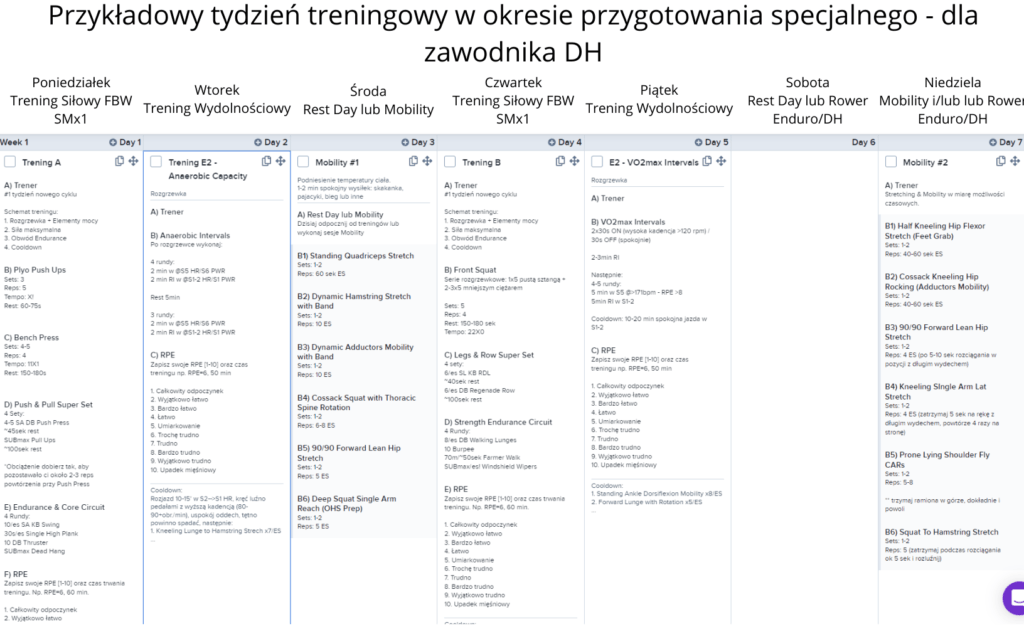
Season is getting closer and closer and with it the first races. How should the last weeks before the competition look like? How to train between a series of races? How to do it in order to increase your capabilities still or maintain them? About this in the next articles, closer to the start season
PS. Use the code “START” and receive 10% off your first month on the TFS Enduro or TFS Downhill program.
Reference:
- Power meter training manual, J.Friel, 2014
- The Mountain Biker’s Training Bible, J.Friel, 2010
- Periodization Training For Sports, T. Bompa, C. Buzzichelli
- The Art of Resilence, Ross Edgley, 2020
- Blueprint: Build a Bulletproof Body for Extreme Adventure in 365 Days, R. Edgley, 2021
- Cycling. A recipe for physical and mental training, Jarosław Michałowski, 2021

